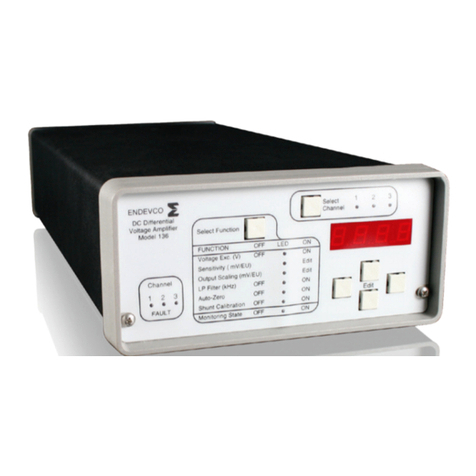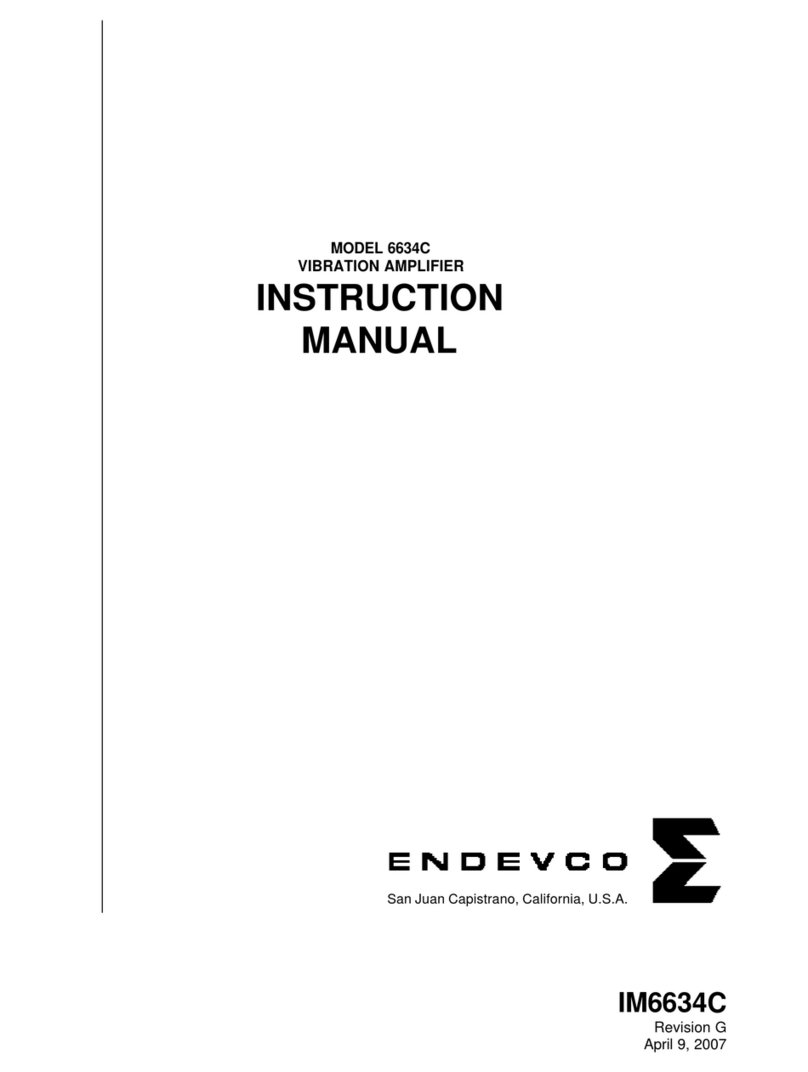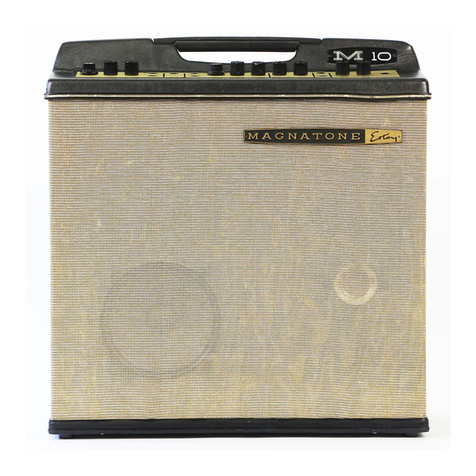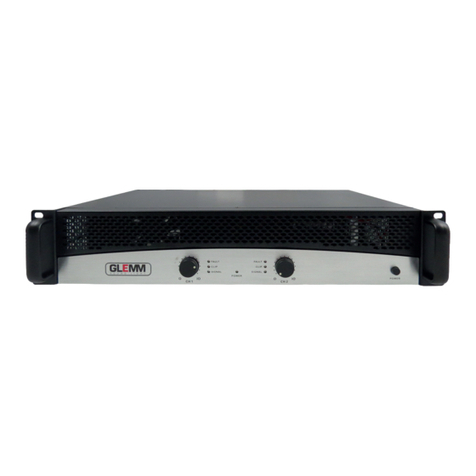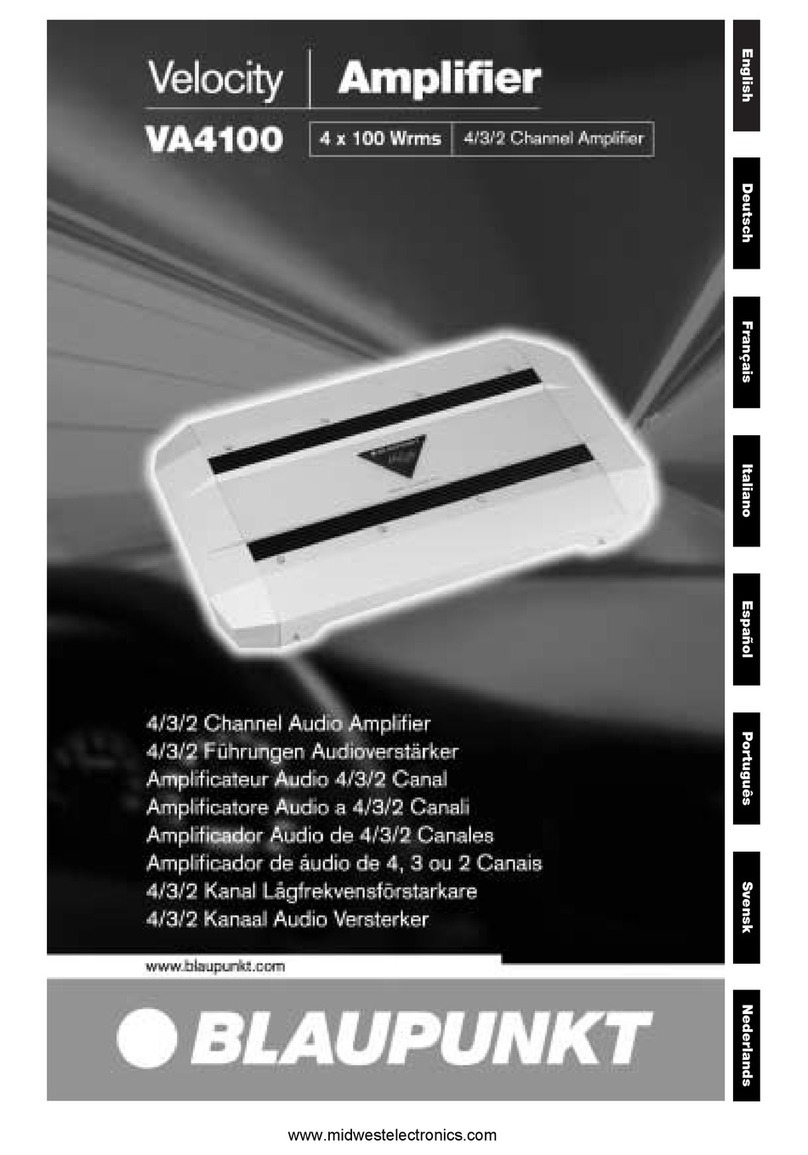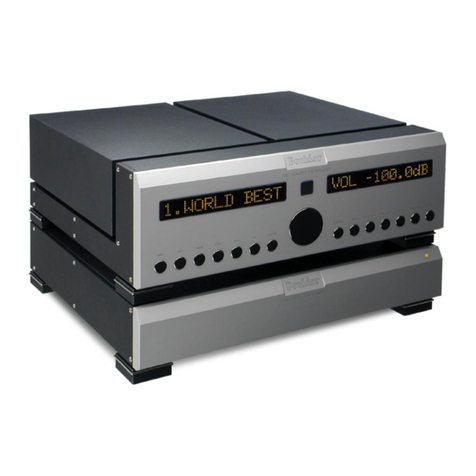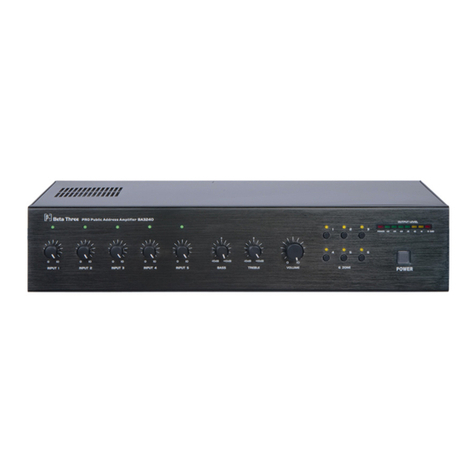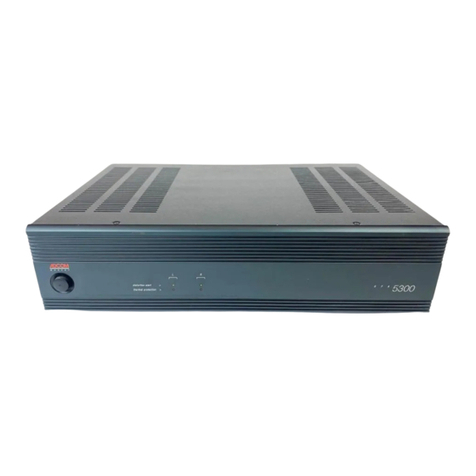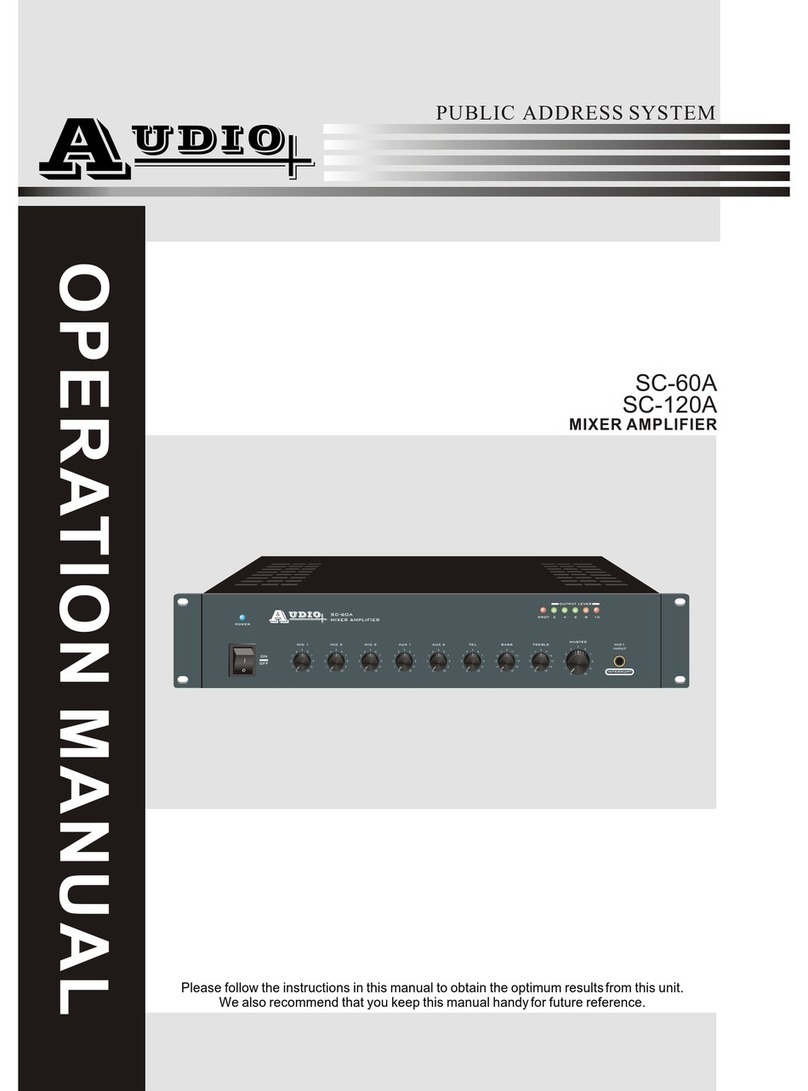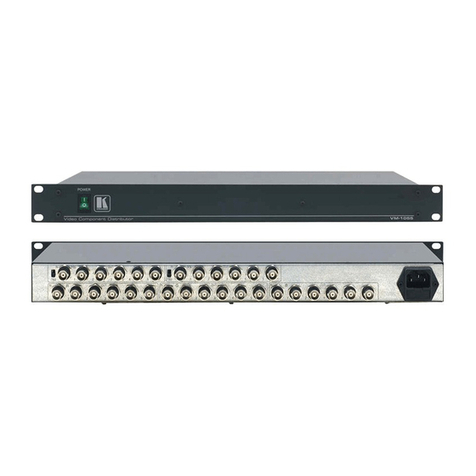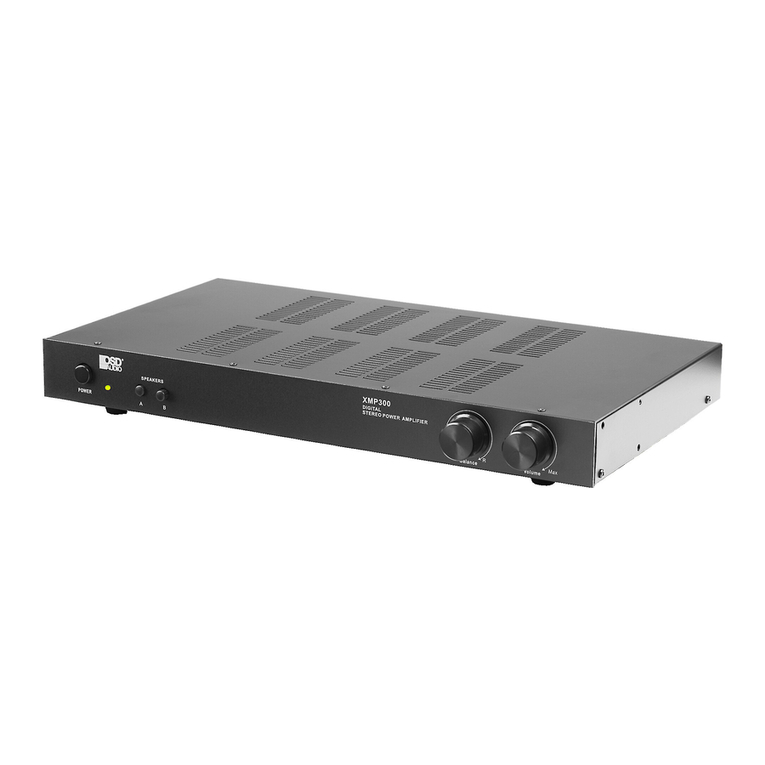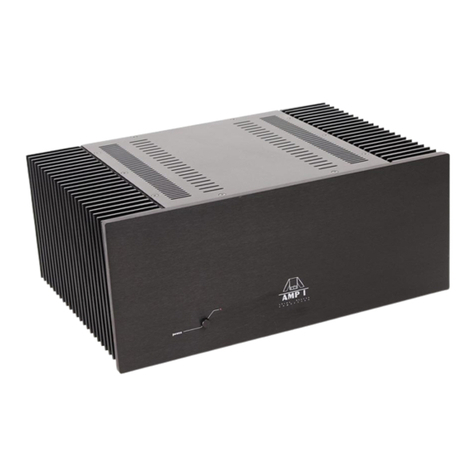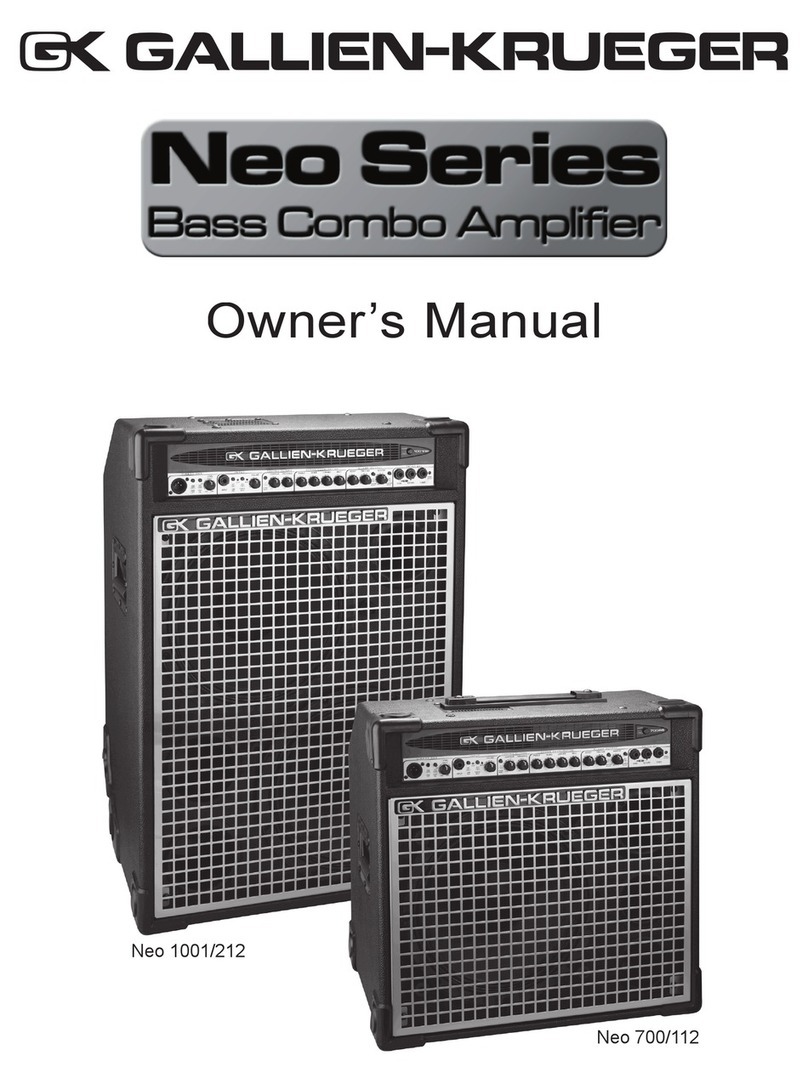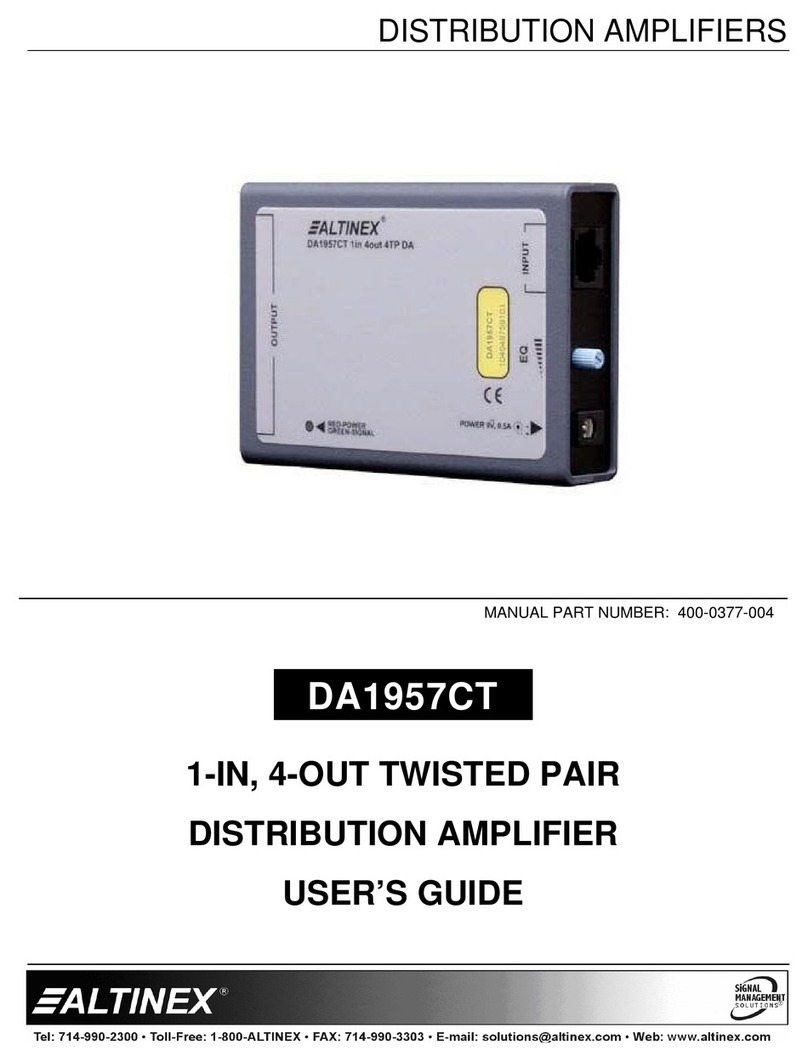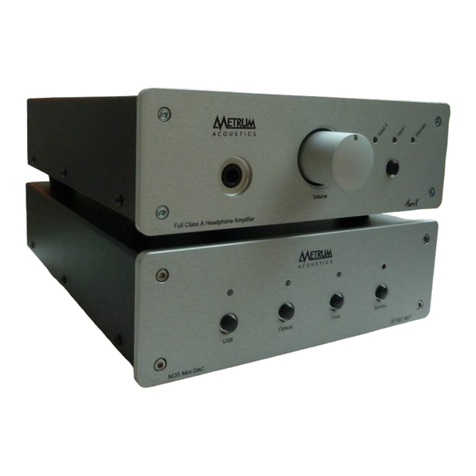ENDEVCO 2680M1 User manual

ENDEVCO www.endevco.com Tel: +1 (866) ENDEVCO [+1 (866) 363-3826]
Piezoelectric accelerometers | Piezoresistive accelerometers | IEPE accelerometers | Variable capacitance accelerometers | Piezoresistive pressure sensors | Piezoelectric pressure sensors |
High intensity microphones | Inertial sensors | Signal conditioners and supportive instrumentation | Cable assemblies
IM 2680/5 083119 1
®
Models 2680M1/2685M1
Airborne Amplier
Instruction Manual # (TBD)

ENDEVCO www.endevco.com Tel: +1 (866) ENDEVCO [+1 (866) 363-3826]
IM 2680/5 083119 2
CONTENTS
01 Products covered. . . . . . . . . . . . . . . . . . . . . . . . . . . . . . . . 3
1.1 Low-pass lters . . . . . . . . . . . . . . . . . . . . . . . . . . . . . . . . 3
02 Product description . . . . . . . . . . . . . . . . . . . . . . . . . . . . . .5
03 Initial inspection . . . . . . . . . . . . . . . . . . . . . . . . . . . . . . . . 6
04 Installation . . . . . . . . . . . . . . . . . . . . . . . . . . . . . . . . . . . 7
04.1 Input Installation . . . . . . . . . . . . . . . . . . . . . . . . . . . . . . . 7
04.1.1 2680 input cable . . . . . . . . . . . . . . . . . . . . . . . . . . . . . . 7
04.1.1.2 Input cable length . . . . . . . . . . . . . . . . . . . . . . . . . . . . 7
04.1.2 2685 input cable . . . . . . . . . . . . . . . . . . . . . . . . . . . . . . 8
04.1.2.1 Input cable length . . . . . . . . . . . . . . . . . . . . . . . . . . . . 8
04.2 Output connector, 2680, 2685 . . . . . . . . . . . . . . . . . . . . . . . . 8
04.3 Powering . . . . . . . . . . . . . . . . . . . . . . . . . . . . . . . . . . . 8
04.4 Signal outputs . . . . . . . . . . . . . . . . . . . . . . . . . . . . . . . . 8
4.4.1 Biased output . . . . . . . . . . . . . . . . . . . . . . . . . . . . . . . . 9
4.4.2 Unbiased output. . . . . . . . . . . . . . . . . . . . . . . . . . . . . . . 9
4.5 Adjustable gain . . . . . . . . . . . . . . . . . . . . . . . . . . . . . . . . 9
4.5.1 Unsoldering the access screw . . . . . . . . . . . . . . . . . . . . . . . 10
4.5.2 Sealing the access screw . . . . . . . . . . . . . . . . . . . . . . . . . 10
4.6 How to calculate gain and output level . . . . . . . . . . . . . . . . . . . 11
4.7 2685 considerations . . . . . . . . . . . . . . . . . . . . . . . . . . . . . 12
4.8 What to look for? . . . . . . . . . . . . . . . . . . . . . . . . . . . . . . 13
5.0 Environmental considerations . . . . . . . . . . . . . . . . . . . . . . . . 15
5.1 EMC capability . . . . . . . . . . . . . . . . . . . . . . . . . . . . . . . 15
5.2 Temperature Effects . . . . . . . . . . . . . . . . . . . . . . . . . . . . . 15
5.3 High temperature accelerometers. . . . . . . . . . . . . . . . . . . . . . 15
6.0 Performance testing . . . . . . . . . . . . . . . . . . . . . . . . . . . . . 16
6.1 Preferred method, 2680 and 2685 . . . . . . . . . . . . . . . . . . . . . 16
6.1.1 Hand-held shaker method. . . . . . . . . . . . . . . . . . . . . . . . . 16
6.1.2 Accelerometer simulator method . . . . . . . . . . . . . . . . . . . . . 18
6.1.3 2680 quick test . . . . . . . . . . . . . . . . . . . . . . . . . . . . . . 19
6.14 2685 quick test . . . . . . . . . . . . . . . . . . . . . . . . . . . . . . 20
6.2 2680 Testing without the sensor. . . . . . . . . . . . . . . . . . . . . . . 21
6.3 Final electrical and mechanical installation . . . . . . . . . . . . . . . . . 22
07 Maintenance and calibration. . . . . . . . . . . . . . . . . . . . . . . . . 24
7.1 Returning the unit . . . . . . . . . . . . . . . . . . . . . . . . . . . . . . 24
Appendix A: Cable installation Recommendations . . . . . . . . . . . . . . . 25
Appendix B: Why a calibration capacitor? . . . . . . . . . . . . . . . . . . . 26

ENDEVCO www.endevco.com Tel: +1 (866) ENDEVCO [+1 (866) 363-3826]
IM 2680/5 083119 3
INSTRUCTION MANUAL
01 PRODUCTS COVERED
This manual covers the model 2680M1 charge amplier and the 2685M1
IEPE (ISOTRON®) signal conditioner and applicable accessories. The full
model number is printed on the label located on the top of the unit. The
below tables describe the numbering system and applicable parameters.
“M” number Gain range Input pulse (mV/
pC). 2680 only
Residual noise
(mV rms)
M1 0.1 to 1.0 50 000 1.5
M2 0.2 to 2.0 25 000 1.5
M3 0.5 to 5.0 10 000 1.5
M4 1.0 to 10 5000 1.5
M5 2.0 to 20.0 2500 1.5
M6 5.0 to 50.0 1000 1.5
M7 10 to 100 500 2.0
1.1 Low-pass lters
An optional low-pass lter is factory installed in the airborne amplier if
specied on the Purchase Order. Available lters are 2-pole Butterworth
lters that provide the unit with a specic frequency response. If an
airborne amplier contains an optional lter, the model number will
contain a three-digit sufx (dash number) to indicate the lter’s -5%
frequency in Hz. The rst two digits are signicant numbers and the third
indicates the numbers of zeroes. As an example, the Model 2680M7-
102 Charge Amplier has a two-pole low-pass lter installed with a at
response from 5Hz (-5%) to 1 kHz (-5%). Tables 2 and 3 provide a list of
the various lters by dash number and frequency responses of each.
Table 1 “M” number
nomenclature for the
2680 and 2685, as
indicated.

ENDEVCO www.endevco.com Tel: +1 (866) ENDEVCO [+1 (866) 363-3826]
IM 2680/5 083119 4
Lower Cutoff Upper Cutoff
Dash
number
-10%
frequency
-5%
frequency
-5%
frequency
-3 dB
typical
-12 dB
typical
None 3 Hz 5 Hz *20 Hz
-101 3 Hz 5 Hz 100 Hz 200 Hz 400 Hz
-201 3 Hz 5 Hz 200 Hz 400 Hz 800 Hz
-501 3 Hz 5 Hz 500 Hz 1 kHz 2 kHz
-102 3 Hz 5 Hz 1 kHz 2 kHz 4 kHz
-202 3 Hz 5 Hz 2 kHz 4 kHz 8 kHz
-502 3 Hz 5 Hz 5 kHz 10 kHz 20 kHz
-103 3 Hz 5 Hz 10 kHz 20 kHz 40 kHz
-203 3 Hz 5 Hz **20 kHz 40 kHz 80 kHz
-402 3 Hz 5 Hz 4 kHz 8 kHz 16 kHz
-250 3 Hz 5 Hz 25 Hz 50 Hz 100 Hz
*10 kHz for M7, **10 kHz for M7
Lower Cutoff Upper Cutoff
None 0.7 Hz 3 Hz ±2Hz 20 kHz*
-101 0.7 Hz 3 Hz ±2Hz 100 Hz 200 Hz 400 Hz
-201 0.7 Hz 3 Hz ±2Hz 200 Hz 400 Hz 800 Hz
-501 0.7 Hz 3 Hz ±2Hz 500 Hz 1 kHz 2 kHz
-102 0.7 Hz 3 Hz ±2Hz 1 kHz 2 kHz 4 kHz
-202 0.7 Hz 3 Hz ±2Hz 2 kHz 4 kHz 8 kHz
-502 0.7 Hz 3 Hz ±2Hz 5 kHz 10 kHz 20 kHz
-103 0.7 Hz 3 Hz ±2Hz 10 kHz 20 kHz 40 kHz
-203 0.7 Hz 3 Hz ±2Hz 20 kHz* 40 kHz 80 kHz
-150 0.7 Hz 3 Hz ±2Hz 15 Hz 30 Hz 60 Hz
*Limit + 5%, -10%
Table 2: Frequency
response based on
“dash” number for the
model 2680 only
Table 3: Frequency
response based on
“dash” number for the
2685 only.

ENDEVCO www.endevco.com Tel: +1 (866) ENDEVCO [+1 (866) 363-3826]
IM 2680/5 083119 5
02 PRODUCT DESCRIPTION
The Endevco Model 2680 and 2685 Series of Airborne Ampliers are
solid-state airborne devices designed for use with piezoelectric and
IEPE transducers. The 2680 and 2685 are essentially identical with the
exception of the front-end (see gures 1 and 2). The airborne ampliers
are potted with polyurethane foam and sealed. Units contain a front-end
circuit to receive the transducer signal, an optional lter to select the at
frequency response range and a potentiometer to set the desired gain of
the amplier’s output.
The 2680’s front end has a charge converter and voltage amplier in the
output. The charge amplier produces an output voltage proportional to
the charge at the input, thus minimizing the effect of input cable length.
The 2680 is designed to accommodate single-ended charge mode
piezoelectric accelerometers and microphones.
The 2685 provides a constant current source and amplier for an IEPE
(ISOTRON) type accelerometer. An IEPE accelerometer has a built-in
amplier that requires a constant current power source. The transducer
provides a low impedance voltage output while maintaining a two-wire
connection. Both the power and the signal output are carried over the
same cable.
The airborne ampliers use hybrid microcircuits to achieve small size, low
weight, and low power consumption. The case of the airborne amplier
is completely isolated from the circuit and an internal electrostatic shield
protects it from stray pickup.
Note that there are no provisions to access TEDS. A TEDS type transducer
can be used with the 2685, but the TEDS chip cannot be interrogated via
the airborne amplier. The 2685 does not monitor the transducer’s bias
excitation voltage. The transducer’s bias should not be confused with the
biased output available on pin C of the 6-pin connector. Pin 6 should
always have a biased output.
Figure 1: Basic
powering circuit similar
to the one used in the
model 2685

ENDEVCO www.endevco.com Tel: +1 (866) ENDEVCO [+1 (866) 363-3826]
IM 2680/5 083119 6
03 INITIAL INSPECTION
The charge amplier is packed in a protective bag and packaged in
shipping cartons containing shock-absorbent materials to prevent in-transit
damage. However, upon receipt of the units, the customer should make
an inspection to be certain that no damage has occurred during shipment.
Obvious damage should be reported immediately to the carrier.
Inspect the contents of the shipping carton and verify that the applicable
accessories listed in Table 4 are included in the shipment with each
airborne amplier.
Should it be necessary to return the amplier to the factory, follow the
instructions in section 7.1 of this manual. It is recommended that an
applications engineer be contacted prior to returning the unit since many
problems can be resolved via telephone of email.
Figure 2: Model 2680
airborne amplier
congured as a charge
amplier.
Figure 3: Model 2685
airborne amplier
congured as an IEPE
(ISOTRON) current
source and voltage
amplier.

ENDEVCO www.endevco.com Tel: +1 (866) ENDEVCO [+1 (866) 363-3826]
IM 2680/5 083119 7
04 INSTALLATION
The charge amplier’s case is drilled with two holes for mounting the unit
to the test specimen. The mounting holes are drilled and counter bored
to accommodate a 6-32 cap screw. Since there are some measurement
difference between the 2680 and 2685, the user should refer to gures 12
A and 12B for measurement information. The mounting hardware for both
airborne amplier models is listed in Table 4.
Quantity Description Endevco part
number
Mfg. part
number
1Mating plug EP38 VP5/4CE6
1 Hood EP35 VS4/16C5
1Potting sleeve EP31 VS4/16C9
1 6-32 ¼”cap screw,
CRES
EH535
1 6-32 ¾” cap screw,
CRES
EH293
To minimize noise pickup, the case of the charge amplier should be
grounded to frame ground through the mounting screws, which act as
grounding lugs. Frame ground is then connected to circuit ground at
some single point to prevent ground loops.
04.1 Input Installation
This section covers the connections between the transducer and the
airborne ampliers.
04.1.1 2680 input cable
The 2680 airborne amplier is congured to operate with charge-mode
transducers thus the input cable must be low-noise treated. Cable
assemblies such as the Endevco 3090C or the premium 3090DV are
recommended. The connector on the airborne amplier is a 10-32 type.
04.1.1.2 Input cable length
Since the 2680 amplier supports high impedance charge-mode
accelerometers, it is important that the cable be as short as possible.
While cable length has no practical effect on sensitivity the high
impedance characteristics make the system susceptible to noise pick-up.
The model 2680 has an input source capacitance of 10 000 pF, maximum.
Thus the capacitance of the accelerometer plus the cable’s capacitance
must not exceed 10 000pf.
For example, using an Endevco 2276 piezoelectric accelerometer over
a distance of 80 feet (24 meters) between the accelerometer and the
airborne amplier. The coaxial cable between the accelerometer and
Table 4 listing standard
accessories’ supplied.
The mfg. part numbers
refer to Viking
Electronics.

ENDEVCO www.endevco.com Tel: +1 (866) ENDEVCO [+1 (866) 363-3826]
IM 2680/5 083119 8
airborne amplier has a nominal capacitance of 30 pF/ foot (92 pF/meter):
Therefore: 80 X 30 = 2400 pF
2400 pF is well within the capacitance range and will work OK, but there
might be some added noise.
04.1.2 2685 input cable
The 2685 is designed to operate with IEPE (ISOTRON) accelerometers,
thus low- noise treated cables are unnecessary. Recommended cable
assemblies are the Endevco Teon C-001-AC-001-X or the Endevco
silicone C-001-AD-001-X. The connector on the airborne amplier is a
10-32 type.
04.1.2.1 Input cable length
The 2685 can support long cables since the accelerometer’s used feature a
low-impedance voltage output. There is a practical limit of approximately
700 feet (213 meters), which will provide a 10V peak-to-peak output up
to 5 kHz. This is based on 30 pF/foot (98 pF/meter), which is a typical
capacitance found on many coaxial cables. Shorter cable lengths will
permit an increase of the maximum frequency.
04.2 Output connector, 2680, 2685
A 5-pin connector is provided for the output signals, ground and power.
The output characteristics and pins are common to both the 2680 and the
2685. The 5-pin connector is a bayonet-locking type. A mating connector
is supplied with the amplier. See gure 1 and 2 for the connector pinout
locations.
04.3 Powering
Power is applied to pins A (+) and D (ground) of the ve-pin connector.
Power should be from a clean DC source of 20 to 32 VDC (28 VDC,
nominal). The power input circuit includes reverse polarity protection thus
a reversed connection will not damage the airborne amplier.
The nominal current requirements are per the following table 5:
Model Description Current, mA
2680 Units with lters 25
2680 Unltered units 20
2685 All versions 30
04.4 Signal outputs
Each airborne amplier has two outputs, biased and/or unbiased. Both
outputs are single-ended with one side connected to circuit ground. When
both outputs are used simultaneously, the parallel combination of both
load resistances must be 10k ohm or greater to meet all specications.
Table 5

ENDEVCO www.endevco.com Tel: +1 (866) ENDEVCO [+1 (866) 363-3826]
IM 2680/5 083119 9
Maximum output voltage is approximately 0 to 5 v (± v pk) depending on
the specic airborne amplier. The output circuits are short-circuit proof,
thus the outputs will withstand an indenite short without damage.
4.4.1 Biased output
The biased output is available from pin C (+) and pin D (ground). This
output is
direct-coupled with an output impedance of less than 50 ohms. With
no input, the airborne amplier produces +2.5 v dc, ±3% at the output.
Output voltage will be approximately +/- 2.5 V pk around this bias level.
Clipping will occur slightly above the O V level and between +5.0 and
+5.3 V.
4.4.2 Unbiased output
The unbiased output is available between pins B (+) and D (ground).
This output is taken from the same source as the biased except a series
decoupling capacitor blocks the DC bias only allowing only the AC
signal to be available at pin B. With the addition of the series capacitor
and bleed resistor in the output, a 0.00 V bias level is established. The
unbiased output is linear from 0 to 4.65 V p-p, or 0 to 5.00 V p-p,
depending on the specic airborne amplier used.
Refer to Table 1-2 for further output data on specic airborne ampliers.
4.5 Adjustable gain
The airborne amplier’s enclosure contains a removable screw to permit
access to a gain potentiometer. The potentiometer enables the user
to adjust the gain to any desired setting within the gain range of the
amplier. For example, in an M3 version; the gain range would be 0.5 to
5 per table 1. The gain-access screw is located on the side of the case
as shown in gure 4. Remove the access screw using a 5/64” hex wrench
with an insulated handle.
Figure 4 illustrates
removal, re-installation
and solder sealing of
the gain adjustment
potentiometer. A
200-watt soldering iron
with a narrow tip is
recommended.

ENDEVCO www.endevco.com Tel: +1 (866) ENDEVCO [+1 (866) 363-3826]
IM 2680/5 083119 10
The gain adjustment is a 12-turn (typical) 500 000-ohm (±0.1%)
potentiometer with mechanical stops at the extreme clockwise (cw) and
counterclockwise (ccw) positions. Maximum resistance (minimum amplier
gain) is obtained in the extreme cw position. Signals are present at both
ends of the potentiometer, but signal changes may not occur during the
nal two turns. A 1/16” (1.6 mm) at blade screwdriver is recommended
for adjusting the potentiometer.
Airborne ampliers shipped as a component of an Endevco system
consisting of an airborne amplier with a cable assembly and either an
accelerometer or microphone; normally have the gain factory-set to a
specic level, and the gain-access screw solder-sealed to the case of the
airborne amplier. The gain-access screw must be sealed to the case
with solder (recommended), glyptol or epoxy for it to meet humidity
specications during operation.
Units shipped as single items of equipment have the gain potentiometer
set to the maximum rated gain and the gain-access screw temporarily
seated in the threaded access hole. Users may adjust the gain to a desired
gain setting prior to installation of an airborne amplier. See table 1 to
determine the applicable gain range.
4.5.1 Unsoldering the access screw
Should it become necessary to remove the screw from a unit that has been
solder sealed, follow the instructions as follows:
• Preheat an oven to 212°F (100°C).
• Place airborne amplier in the preheated oven for a period of time
sufcient for the airborne amplier to stabilize.
• Insert the 5/64”Allen wrench into the access screw (per gure 4) and
place a soldering iron adjacent to the access screw as shown in gure
4.
• Apply ccw torque to the Allen wrench and remove the access screw
when solder seal is molten.
CAUTION
When removing the access screw, care should be exercised to prevent
molten solder from entering the airborne amplier.
4.5.2 Sealing the access screw
A new access screw should be used to seal the gain adjust hole. Installing
used access hole screws could prevent the airborne amplier from meeting
the humidity specications. Follow the steps below for installing and
sealing the new screw:
• Install a new access screw into the gain adjust hole.
• Preheat oven to 212°F (100°C).

ENDEVCO www.endevco.com Tel: +1 (866) ENDEVCO [+1 (866) 363-3826]
IM 2680/5 083119 11
• Place airborne amplier in the preheated oven for a period of time
sufcient for the airborne amplier to stabilize.
• Remove the airborne amplier from the oven
• Apply a small amount of rosin core solder (63-37) to the recessed area
around the access screw to form a solder seal (see gure 4).
4.6 How to calculate gain and output level
Any of the methods described in section six may be used. It is necessary
to know the following factors:
Accelerometer’s sensitivity in mV/g (2685) or pC/g (2680)
Desired full-scale output from the airborne amplier
Determine the ampliers peak sensitivity in pC/g or mV/g: (1)
As = Eo
Fs
Where: As = Ampliers charge sensitivity or voltage sensitivity in mV/g.
Eo = Ampliers peak full-scale output in mV peak
FS = Amplier’s desired peak full-scale output in g peak
The next step is to compute the required gain (Aq): (2)
Aq = As
Sq
Where: Sq = Sensor’s sensitivity in pC/g or mV/g
Make sure that the output signal amplitude is compatible with
the readout equipment: (3)
As = Eo
Fs
As = System sensitivity
Where: Eo = Output in mV peak
Fs = Desired full scale (g peak)
Using one of the signal sources described in section 4, a DMM and/or an
oscilloscope, make the necessary adjustment of the potentiometer. The
signal source should be set 100Hz.
For example, suppose a system consisting of a charge-mode piezoelectric
accelerometer is used to measure ± 50g peak, full scale with a 2680
amplier (which has a 2500 mV full-scale output).

ENDEVCO www.endevco.com Tel: +1 (866) ENDEVCO [+1 (866) 363-3826]
IM 2680/5 083119 12
Using the previous equation:
As = 2500mV
50g
= 50 mV/g
If the airborne amplier used is the model 2685, the same equation is
used, but the transducers sensitivity is xed and marked on the transducer
and its calibration certicate.
4.7 2685 considerations
This section shows how to determine if the accelerometer’s output is
compatible with the 2685.
Figure 5 shows a typical transfer function and the effects of the compliance
and bias voltage levels. The specied bias level indicated is measured at
room temperature and will change as the operating temperature changes.
Note that compliance voltage is the supply voltage minus 2-3 Volts due to
a voltage drop in the regulator circuit.
Use the following equations to determine the maximum full-scale peak
output voltage from the IEPE accelerometer.
To determine the maximum positive voltage:
Fs = (Es – 1) – Eb
To determine the maximum negative voltage:
– Fs = Eb – 2
Where: Fs = Full scale output voltage (peak)
Es = DC compliance voltage
Eb = Bias voltage (from accelerometer calibration certicate
Figure 5 showing
the transfer function
of a typical IEPE
accelerometer.

ENDEVCO www.endevco.com Tel: +1 (866) ENDEVCO [+1 (866) 363-3826]
IM 2680/5 083119 13
4.8 What to look for?
Exercise caution and do not operate too close to the full - scale output.
Clipping can occur (Figure 6D) once the signal reaches 0 volts or the
maximum voltage and in the region just prior to clipping, the amplitude is
non-linear (see gure 5).
An oscilloscope with an FFT function is an excellent tool for checking
signals close to the full-scale output. When using the FFT mode, a
Hanning window is recommended.
Using the FFT mode on the oscilloscope, view the frequency domain and
observe the presence of harmonics. The below image shows the spectrum
of an undistorted sine wave. Only a single frequency is present.
In some cases the time domain display on the oscilloscope can appear as
clean as gure 6A, but there may be distortion present that will only be
detectable in the frequency domain or on a harmonic distortion analyzer.
A clean sine wave in
the time domain
(Figure 6A)
(Figure 6B)
AmplitudeAmplitude
Frequency

ENDEVCO www.endevco.com Tel: +1 (866) ENDEVCO [+1 (866) 363-3826]
IM 2680/5 083119 14
Notice the fundamental frequency, on the left, and the presence of
harmonics in gure 6C.
Figure 6D is an example of the presence of clipping as seen in the time
domain. In this case further analysis using the FFT mode is unnecessary
since the problem is obvious.
(Figure 6C)
(Figure 6D)
AmplitudeAmplitude
Frequency
Frequency

ENDEVCO www.endevco.com Tel: +1 (866) ENDEVCO [+1 (866) 363-3826]
IM 2680/5 083119 15
5.0 ENVIRONMENTAL CONSIDERATIONS
See the applicable product datasheet for applicable environmental
specications and ensure that the airborne ampliers are operating within
these specications.
The airborne ampliers are rated to 100% relative humidity and are in
compliance with MIL-STD-810D, Method 507.2, procedure III. In order
to comply with the specications, the gain access screw must be solder-
sealed. The humidity rating does not include the cable’s connectors thus
some precautions may be necessary to protect the connectors.
5.1 EMC capability
The airborne ampliers meet the requirements of MIL-STD-826, CLASS
Am. The 2680 is also in compliance with MIL-I-618D; MSFC-SPEC-279,
CLASS1; AF/BSD EXHIBIT 62-87.
5.2 Temperature Effects
Airborne ampliers can be operated over a temperature of -67° F to 212°
F (-73° C to 100° C). The gain change over the operating temperature
range is illustrated in Figure 7.
% of maximum specied gain
Gain stability with temperature vs. gain setting
5.3 High temperature accelerometers
When accelerometers are exposed to high temperature extremes the
internal resistance decreases. High temperature accelerometers usually
specify resistance at room temperature and at the maximum temperature.
The specied source resistance of the 2680 is 3 M Ω, minimum.
Gain change in ± %
Figure 7: A near
linear plot of the
temperature effect
as a function of gain.
Each data point
is taken over the
operating temperature
range.

ENDEVCO www.endevco.com Tel: +1 (866) ENDEVCO [+1 (866) 363-3826]
IM 2680/5 083119 16
As an example, let’s assume that we are going to use a model 2230 high-
temperature accelerometer. The room temperature resistance is 1G Ω that
would work well with the 2680, but the resistance drops to 100kΩ when
the accelerometer reaches 900°F (482°C) which is well below the minimum
source resistance requirement of the 2680.
In this instance, consider using a 2685 airborne amplier in conjunction
with a 2771C in-line charge converter. The 2771C has a minimum
source resistance requirement of 100k, which will work over the entire
temperature range.
6.0 PERFORMANCE TESTING
It is sometimes desirable (or required) to test the integrity of a system after
installation. This section will provide both a quick test and an in-depth test
for both the 2680 and 2685. The quick test might be conducted prior to
installation to verify the unit is operational.
The most efcient way to test the performance is described in section 6.1.
If these instruments are unavailable, section 6.2 suggests methods where
standard laboratory instrumentation can be used to effectively perform
the tests. See the appropriate Endevco technical paper for further tests, if
required.
6.1 Preferred method, 2680 and 2685
Using one of the Endevco test instruments discussed herein is the easiest
and most effective way to conduct a performance test on either of the
airborne ampliers. The two instruments and their applications are
discussed below.
6.1.1 Hand-held shaker method
The Endevco model REF2520/R (gure 9) reference shaker is a highly
convenient way to test and conrm the calibration and performance of
the accelerometer, cable and amplier with one simple test. The vibration
level is limited to 1g peak.
Figure 8: Model
2771C in-line charge
converter to be
installed between the
accelerometer and the
2685’s input connector.

ENDEVCO www.endevco.com Tel: +1 (866) ENDEVCO [+1 (866) 363-3826]
IM 2680/5 083119 17
Equipment required:
• 28 volt power supply with an output mA meter
• Oscilloscope
• Digital multimeter
Follow the below steps:
1. Apply 28 VDC between pins A (+) and D and conrm that the current
is within the specications in Table 4. Allow about >3 minutes for
warm-up.
2. Install a 10k Ω, ¼ watt resistor between pins C & D.
3. Attach an oscilloscope to pins C and D.
4. Set the reference shaker frequency to 100Hz.
5. Observe a 100 Hz undistorted sine wave on the oscilloscope. If the
oscilloscope is DC coupled a DC bias of 2.50 volts (±3%)should also
be observed.
Figure 9: A handheld shaker
(Endevco REF2520) is ideal for
testing system performance.
The shaker provides a one g
sine vibration level at selectable
frequencies. The accelerometer
under test is attached to the top
of the shaker.

ENDEVCO www.endevco.com Tel: +1 (866) ENDEVCO [+1 (866) 363-3826]
IM 2680/5 083119 18
6.1.2 Accelerometer simulator method
An accelerometer simulator is also a good source for testing the
performance of the 2680 or 2685. In this instance, the accelerometer
is absent from the circuit. The Endevco model 4830B (gure 10) is an
example of an accelerometer simulator.
Equipment required:
• 28 volt power supply with an output mA meter
• Digital storage oscilloscope
• Digital multimeter
When using a simulator, follow the below steps:
1. Apply 28 VDC between pins A (+) and D and conrm that the current
is within the specications in Table 4. Allow about >3 minutes for
warm-up.
2. Install a 10k Ω, ¼ watt resistor between pins C & D.
3. Attach an oscilloscope to pins C and D.
4. Use the charge output for testing the 2680 or the IEPE output for
testing the 2685.
5. Set the simulator frequency to 100Hz.
6. Observe a 100 Hz undistorted sine wave on the oscilloscope. If the
oscilloscope is DC coupled a DC bias of 2.50 volts (±3%) should be
observed.
Figure 10: Endevco
model 4630B hand-held
accelerometer simulator
with the IEPE and charge
output connectors
identied.
IEPE Charge

ENDEVCO www.endevco.com Tel: +1 (866) ENDEVCO [+1 (866) 363-3826]
IM 2680/5 083119 19
6.1.3 2680 quick test
This section provides a method to perform a quick functional test using
common laboratory measurement equipment.
Equipment required:
• 28 volt power supply with an output mA meter
• Digital storage oscilloscope
• Digital multimeter
1. Apply 28 Volts between pins A (+) and D. and conrm that the
current is within the specications in table 4.
2. Connect a 10k Ω (minimum) resistor between pins C and D.
3. With a DMM, measure the DC voltage across the 10k Ω resistor. The
voltage should read 2.50 VDC ±3%.
4. Connect a charge-mode piezoelectric accelerometer to the10-32
input connector using low-noise cable.
5. Connect an oscilloscope to either/or Pins B and D or C&D. AC
coupling is recommended if using pins C&D.
6. Tap the base of the accelerometer with a wooden pencil, or a plastic
screwdriver handle.
7. Look for an output response on the oscilloscope screen. Figure 11 is
an example of a response from a hard strike.
8. If a suitable response is observed on the oscilloscope, the test is
complete.
Figure 11: The left
side of the trace
shows the initial
strike followed by
the “ring” from
the accelerometers
resonance. Other
patterns are possible
from a “good” system.

ENDEVCO www.endevco.com Tel: +1 (866) ENDEVCO [+1 (866) 363-3826]
IM 2680/5 083119 20
6.14 2685 quick test
Equipment required:
• Digital storage oscilloscope
• Digital multimeter
• 28 VDC power supply with an output mA meter
1. Apply 28 Volts between pins A (+) and D. and conrm that the
current is within the specications in table 4.
2. Connect a 10k Ω (minimum) resistor between pins C and D.
3. With a DMM, measure the DC voltage across the 10k Ω resistor. The
voltage should read 2.50 VDC ±3%.
4. Connect an IEPE accelerometer to the 10-32 input connector.
5. Connect an oscilloscope to either/or Pins B and D or C&D. AC
coupling is recommended if using pins C&D.
6. Tap the base of the accelerometer with a wooden pencil, or a plastic
screwdriver handle.
7. Look for an output response on the oscilloscope screen. Figure 11 is
an example of a response from a hard strike.
8. If a response is observed on the oscilloscope, the test is complete.
9. Install the accelerometer cable in such a way that the DC voltage
can be measured. This is best accomplished using a pair of 10-
32 to BNC cables (Endevco 3061) joined by a BNC “T” connector
(Amphenol 112461, or equiv.) per gure 5.
10. Refer to the accelerometer’s calibration certicate and note the bias
Voltage.
11. With the power applied (28 VDC), measure the transducer’s bias
voltage as shown in gure 12. It should read approximately the
same as the bias voltage recorded on the calibration certicate.
Note that the ambient temperature affects the transducer’s bias
voltage level. The calibration temperature is recorded on the
certicate.
Figure 12: A “T”
connector can be used
between two BNC to
10-32 cables allowing
for the measurement
of the bias voltage at
the male center of the
connector.
To DMM
To accelerometer
BNC “T” CONNECTOR
To 2685
This manual suits for next models
1
Table of contents
Other ENDEVCO Amplifier manuals
